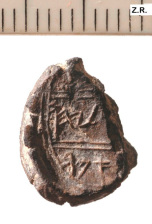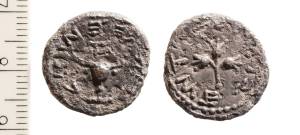
PREV ARTICLE
NEXT ARTICLE
FULL ISSUE
PREV FULL ISSUE
THE TEMPLE MOUNT SIFTING PROJECT
Jere Bacharach (our second E-Sylum email subscriber) forwarded this blog article about the Temple Mount Sifting Project. Thanks.
-Editor

About the Project
Our Story
Our project began in 1999 when the Northern Branch of the Islamic Movement conducted illegal renovations on the Temple Mount and disposed over 9,000 tons of dirt mixed with invaluable archaeological artifacts. Though Israeli antiquities law requires a salvage excavation before construction at archaeological sites, this illegal bulldozing destroyed innumerable artifacts: veritable treasures that would have provided a rare glimpse of the region’s rich history. The earth and the artifacts within were dumped as garbage in the nearby Kidron Valley. In a bold move, archaeologists Dr. Gabriel Barkay and Zachi Dvira retrieved the matter from the dump, and in 2004, they started sifting it. Their initiative became the Temple Mount Sifting Project (TMSP) with the goal of rescuing ancient artifacts and conducting research to enhance our understanding of the archeology and history of the Temple Mount. Over the past 12 years, it has grown into a project of international significance. With the help of nearly 200,000 volunteers, thousands of valuable finds have been discovered.
Here are a couple of the numismatic finds mentioned. -Editor
The impression on the back of the sealing indicated it was originally attached to a fabric parcel or a sack, and it may be assumed that it sealed some precious goods that were kept in the Temple treasury which was managed by the priests. This sealing is the first ever evidence of ancient Hebrew writing from the Temple Mount and to the administrative activity which took place in the First Temple. To date, the Sifting Project has uncovered more than five thousand coins, ranging from tiny silver Persian Period coins (4th century BCE) until modern times. The many coins that were found in the rubble testify to the rich past of the Temple Mount. The first coin recovered in the sifting work was very exciting due to its symbolic nature. It was minted during the First Revolt against the Romans that preceded the destruction of the Second Temple. It bore the phrase “For the Freedom of Zion” (חרת ציון). The name “Zion” was the name of the Temple Mount in ancient time. The find was particularly meaningful, inasmuch as it was in rubble from the Temple Mount which was one of the focal points of the fighting.
It appears that these coins were minted on the Temple Mount itself by the Temple authorities. The half-shekel tax for the Temple, mentioned in the Book of Exodus (30:13-15), required every male to pay half a shekel to the Temple every year. The coin was well preserved, although it bears scars from a fire which may have been the conflagration that caused the destruction of the SecondTemple in 70 AD. This is the first time that this type of coin that originates from the Temple Mount itself. To read the complete article, see:
Wayne Homren, Editor The Numismatic Bibliomania Society is a non-profit organization promoting numismatic literature. See our web site at coinbooks.org. To submit items for publication in The E-Sylum, write to the Editor at this address: whomren@gmail.com To subscribe go to: https://my.binhost.com/lists/listinfo/esylum All Rights Reserved. NBS Home Page Contact the NBS webmaster 
|

